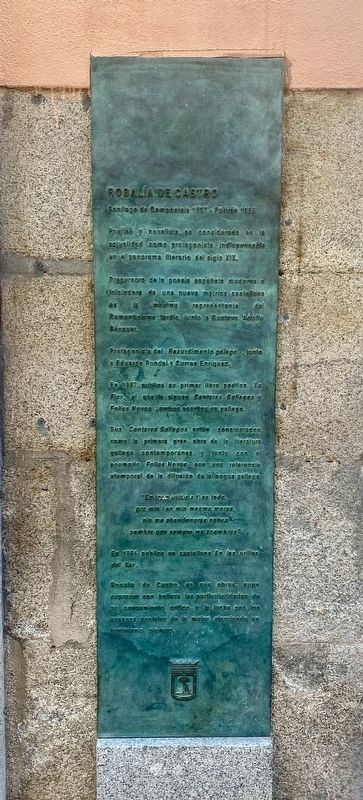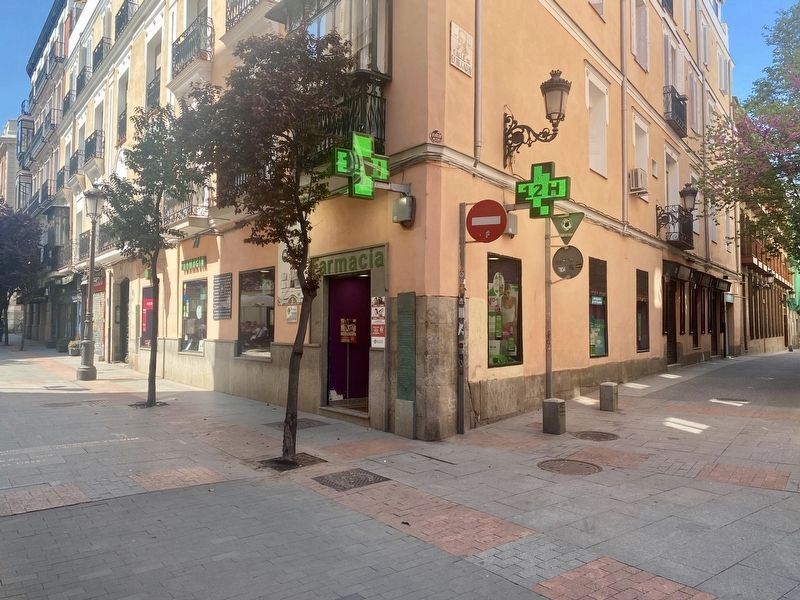Barrio de las Letras in Madrid, Spain — Southwestern Europe (Iberian Peninsula)
Rosalía del Castro
Santiago de Compostela 1837 - Padrón 1885
Poetisa y novelista, es considerada en la actualidad como protagonista indispensable en el panorama literario del siglo XIX.
Precursora de la poesía española moderna e iniciadora de una nueva métrica castellana es la máxima representante del Romanticismo tardio, junto a Gustavo Adolfo Bécquer.
Protagonista del Rexurdimento galego, junto a Eduardo Pondal y Curros Enríquez.
En 1857 publica su primer libro poético, La Flor al que le siguen Cantares Gallegos y Follas Novas ambos escritos en gallego.
Sus Cantares Gallegos están considerados como la primera gran obra de la literatura gallega contemporánea y junto con ell poemario Follas Novas son una referencia atemporal de la difusión de la llengua gallega.
"En todo estás a ti es todo,
pra min i en min mesma moras,
nin me abandonarás nunca
sombra que sempre me asombras"
En 1884 publica en castellano En las orillas del Sar.
Rosalía de Castro, en sus obras, supo expresar con belleza las particularidades de Su pensamiento crítico y la lucha por los avances sociales de la mujer, ejercierciendo un feminismo pionero.
A poet and novelist, she is currently considered an indispensable protagonist in the literary panorama of the 19th century.
She was the forerunner of modern Spanish poetry and the initiator of a new Castilian metric, as well as being the most noted representative of late Romanticism, along with Gustavo Adolfo Bécquer.
She was a leader of the Galician Renaissance, together with Eduardo Pondal and Curros Enríquez. In 1857 she published her first volume of poetry, La Flor, which was then followed by Cantares Gallegos and Follas Novas, both written in Galician.
"You are in everything, you are everything,
for me and in me you dwell,
nor will you ever leave me
a shadow that always amazes me"
In 1884 she published in Spanish On the banks of the Sar.
Rosalía de Castro, in her works, was able to beautifully express the peculiarities of her critical thinking and the fight for the social progress of women, exercising a pioneering feminism.
Topics. This historical marker is listed in these topic lists: Arts, Letters, Music • Women. A significant historical date for this entry is May 17, 1863.
Location. 40° 24.828′ N, 3°
41.974′ W. Marker is in Madrid. It is in Barrio de las Letras. Marker is at the intersection of Calle de las Huertas and Calle de Echegaray, on the left when traveling east on Calle de las Huertas. Touch for map. Marker is in this post office area: Madrid 28014, Spain. Touch for directions.
Other nearby markers. At least 8 other markers are within walking distance of this marker. José Zorrilla y Moral (a few steps from this marker); Dominguín (within shouting distance of this marker); María de Zayas Sotomayor (within shouting distance of this marker); Miguel de Cervantes (within shouting distance of this marker); Palacio de Los Duques de Santoña (within shouting distance of this marker); Marcelino Menendez y Pelayo (within shouting distance of this marker); Miguel de Cervantes Saavedra (within shouting distance of this marker); Mentidero de Representantes (about 90 meters away, measured in a direct line). Touch for a list and map of all markers in Madrid.
Also see . . . Rosalía de Castro (Wikipedia).
Excerpt: "María Rosalía Rita de Castro (23 February 1837 – 15 July 1885), was a Galician poet, strongly identified with her native Galicia and the celebration of the Galician language...Rosalía published her first collection of poetry in Galician, Cantares gallegos ("Galician Songs"), on 17 May 1863. This date, 17 May, is now known as the Día das Letras Galegas ("Galician Literature Day"), and commemorates Rosalía's achievement by dedicating, every year, this special day to a different writer, who must also write in the Galician language, since 1963. Día das Letras Galegas is an official holiday in the Autonomous Community of Galicia."(Submitted on August 22, 2022.)
Credits. This page was last revised on February 2, 2023. It was originally submitted on August 21, 2022, by Andrew Ruppenstein of Lamorinda, California. This page has been viewed 49 times since then and 4 times this year. Photos: 1. submitted on August 21, 2022, by Andrew Ruppenstein of Lamorinda, California. 2. submitted on August 22, 2022, by Andrew Ruppenstein of Lamorinda, California.

